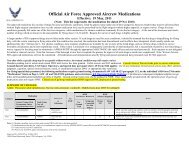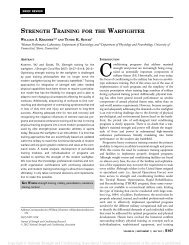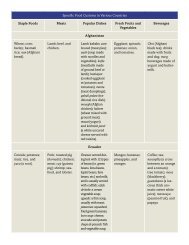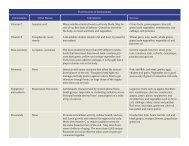Force Health Protection: Nutrition and Exercise Resource Manual
Force Health Protection: Nutrition and Exercise Resource Manual
Force Health Protection: Nutrition and Exercise Resource Manual
Create successful ePaper yourself
Turn your PDF publications into a flip-book with our unique Google optimized e-Paper software.
This EER is the amount of kcals you need to eat daily to have<br />
an energy balance of “zero” <strong>and</strong> maintain your current body weight.<br />
If you restrict the number of kcals you eat per day, your BMR will<br />
decrease because your body will sense that it is being “starved”. If<br />
your goal is to lose weight, you should lower your caloric intake<br />
only slightly <strong>and</strong> engage in a well rounded exercise program. Your<br />
goal should be to lose 1/2 - 1 lbs. per week. If you are losing more<br />
weight than this, you are losing water <strong>and</strong> lean tissue (muscle).<br />
If you want to gain weight, your goal should be to gain 1/2 - 1 lbs. per<br />
week. The objective is to gain lean mass, not fat. <strong>Exercise</strong> routinely,<br />
including strength training, <strong>and</strong> increase your caloric intake by using the<br />
Food Guide Pyramid guidelines (discussed in Chapter 3). Also, eat healthy<br />
snacks between meals.<br />
If you have specific questions about weight management <strong>and</strong> kcal<br />
requirements, consult the Navy <strong>Nutrition</strong> <strong>and</strong> Weight Control Self-Study<br />
Guide (NAVPERS 15602A at http://www-nehc.med.navy.mil <strong>and</strong> http://<br />
www.bupers.navy.mil/services under “Navy <strong>Nutrition</strong> <strong>and</strong> Weight Control),<br />
or talk to a Registered Dietitian, your Comm<strong>and</strong> Fitness Coordinator, or your<br />
primary health care provider.<br />
Body Composition<br />
The Body Mass Index (BMI) is commonly calculated for assessing<br />
body composition. It is a ratio of body weight in lbs. to body height<br />
in inches. Calculate your BMI in Worksheet 1-3 <strong>and</strong> compare it to<br />
the classifications in Table 1-2.<br />
Worksheet 1-3. Calculate Your BMI<br />
Your BMI = x 705 ÷ ( ) 2 = .<br />
Body Weight (lbs) Height (inches)<br />
Table 1-2. Classifications for BMI Ratios<br />
Ratio Classification<br />
< 20 Underweight<br />
20-25 Normal<br />
25-30 Overweight<br />
> 30 Obese<br />
<strong>Nutrition</strong> <strong>and</strong> <strong>Exercise</strong> <strong>Resource</strong> <strong>Manual</strong> 5






![Body Composition and Military [PDF] - Human Performance ...](https://img.yumpu.com/43269347/1/190x245/body-composition-and-military-pdf-human-performance-.jpg?quality=85)
![Tips for Grocery Shopping [PDF]](https://img.yumpu.com/37447379/1/190x245/tips-for-grocery-shopping-pdf.jpg?quality=85)



![Synthetic Drugs [PDF] - Human Performance Resource Center](https://img.yumpu.com/37447322/1/190x245/synthetic-drugs-pdf-human-performance-resource-center.jpg?quality=85)


